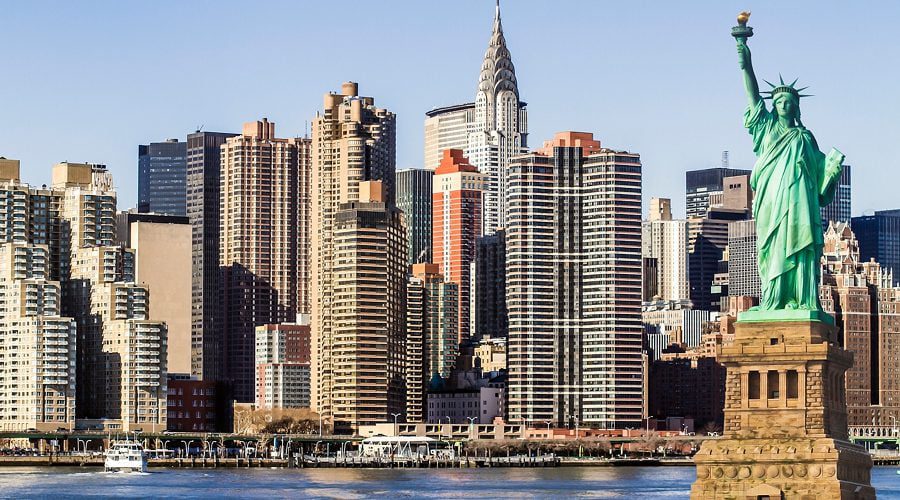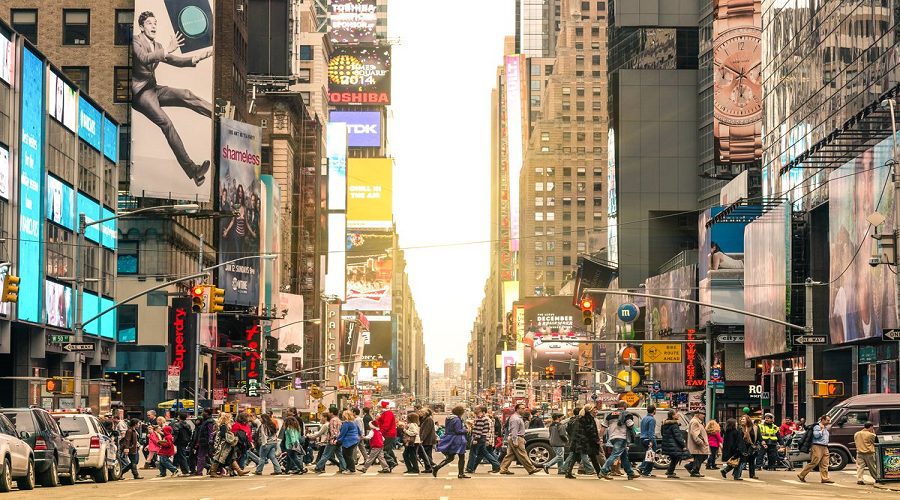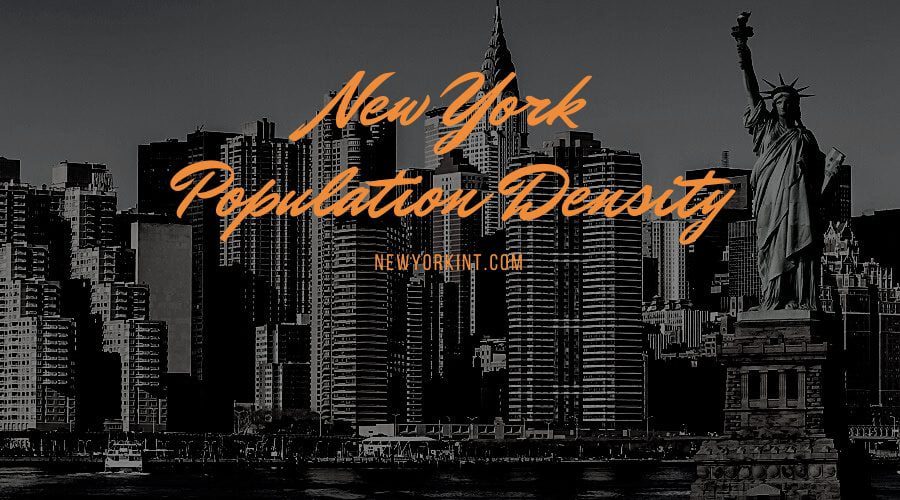New York City stands out as a beacon of urban life, attracting millions with its cultural offerings, diverse job opportunities, and iconic status. However, this vibrant city also comes with a unique characteristic: high population density. In 2024, an estimated 26,403 people reside within each square mile of the city, translating to a significant concentration of individuals compared to the national average of 88 people per square mile. This density makes New York City the most densely populated major city in the United States.
What is the New York population density?

Several factors contribute to this high density. The city occupies a limited land area compared to its population, leading to concentrated development within its borders. New York City also serves as a hub for economic opportunities, attracting individuals seeking career advancement, diverse job markets, and a vibrant cultural scene. Additionally, the city boasts a well-developed public transportation system that allows residents to live centrally and access various areas without relying solely on cars.
While high density offers a unique urban experience, it also presents certain challenges. The large population concentration creates an increased demand for resources, putting pressure on housing availability, infrastructure capacity, and public services. Traffic congestion, competition for resources, and potential strains on infrastructure are some potential consequences of such high density.
It’s important to note that population density varies significantly across New York City’s five boroughs. Notably, Manhattan holds the highest density of over 70,000 people per square mile. While high density presents its own set of challenges, it also fosters a vibrant and diverse urban environment. New York City residents enjoy walkable neighborhoods, accessible amenities, and a dynamic atmosphere that thrives on the close proximity of a large and diverse population.
Ultimately, New York City’s high population density is a defining characteristic that shapes its unique urban experience. While it comes with challenges, it also contributes to the city’s dynamism and vibrancy, making it a truly unparalleled metropolis.
Is New York the most densely populated city in the world?

New York City is the most densely populated city in the world. According to 2012 census data, New York’s population density is 5,587 people per square mile. This makes New York more densely populated than any other city in the world and more than twice as dense as London, which has 2,717 people per square mile. Other major cities with high population densities include Tokyo (3,538 people per square mile), Mumbai (2,973 people per square mile), and Seoul (2,756 people per square mile).
New York Area and Population Density
New York State has an overall population density of 421 people per square mile, with an area of 47,126 square miles. This means that there is a total of 1,847 people per square mile in the state. The density is highest in the southwestern part of the state and lowest in the northeastern part. The counties with the highest population densities are Nassau County (1,953 people per square mile), Kings County (1,840 people per square mile), and New York County (1,611 people per square mile).
New York City is also the most densely populated major city in the country. Nearly 43 of New York state’s population live in the 305 square miles that make up New York City. That’s more people than live in Los Angeles County, which has a population of nearly 10 million. The density of people in New York City is more than five times that of San Francisco, which has the next highest population density.
The most populous counties in New York are Kings County (2,648,771), Queens County (2,358,582), and New York County (1,664,727). Each county has a population of over one million people. The three most populated counties are closely followed by Bronx County with 1,615,451 residents. Manhattan has the largest population density with 5,526 people per square mile.
| Country | |
|---|---|
| State | |
| Region | Mid-Atlantic |
| Constituent counties (boroughs) | Bronx (The Bronx) Kings (Brooklyn) New York (Manhattan) Queens (Queens) Richmond (Staten Island) |
| Historic colonies | New Netherland Province of New York |
| Settled | 1624 (approx) |
| Consolidated | 1898 |
| Named for | James, Duke of York |
| • Type | Strong mayor-council |
| • Body | New York City Council |
| • Mayor | Eric Adams (D) |
| • Total | 472.43 sq mi (1,223.59 km2) |
| • Land | 300.46 sq mi (778.18 km2) |
| • Water | 171.97 sq mi (445.41 km2) |
| Elevation | 33 ft (10 m) |
| • Total | 8,804,190 |
| • Rank | 1st in the United States 1st in New York State |
| • Density | 29,302.66/sq mi (11,313.81/km2) |
| • Metro | 20,140,470 (1st) |
| Demonym | New Yorker |
| Time zone | UTC−05:00 (EST) |
| • Summer (DST) | UTC−04:00 (EDT) |
| ZIP Codes | 100xx–104xx, 11004–05, 111xx–114xx, 116xx |
| Area code(s) | 212/646/332, 718/347/929, 917 |
| FIPS code | 36-51000 |
| GNIS feature ID | 975772 |
| International airports | John F. Kennedy (JFK) LaGuardia (LGA) Newark Liberty (EWR) |
| Rapid transit system | New York City Subway, Staten Island Railway, PATH |
| GDP (City, 2020) | $830 billion (1st) |
| GMP (Metro, 2020) | $1.67 trillion (1st) |
| Largest borough by area | Queens (109 square miles or 280 square kilometers) |
| Largest borough by population | Brooklyn (2020 Census 2,736,074) |
| Largest borough by GDP (2020) | Manhattan ($610.4 billion) |
| Website | www.nyc.gov |
| Official name | Statue of LibertyGuggenheim Museum |
| Type | Cultural |
| Criteria | Statue of Liberty: i, Guggenheim Museum: ii |
| Designated | 1984 (Statue of Liberty, 8th session)2019 (Guggenheim Museum, 43rd session) |
| Part of | The 20th-Century Architecture of Frank Lloyd Wright (Guggenheim Museum) |
| Reference no. | Statue of Liberty: 307Guggenheim Museum: 1496-008 |
| Region | Europe and North America |
New York Gender and Religion Statistics
New York State is home to a diverse population that practices many religions. Seventy percent of its inhabitants report that they are religious, making New York one of the most religiously diverse states in the country. The largest religion in New York State is Christianity, with Protestants making up the majority of followers. There are also significant numbers of Muslims, Hindus, Jews, and Buddhists living in the state. Other religions represented include Muslim Chinese Christians, Jehovah’s Witnesses, and Baha’is.
There are people from all races and creeds living in the state of New York. The different ethnic identities have led to a rich cultural diversity in this region. This diversity has allowed for the development of unique cuisines, music, and art forms. There are also many amazing places to visit in New York, such as Central Park, Niagara Falls, and Times Square.
New York City has long been known for its diverse population, with people from over 200 nationalities counted to be a part of New York as of 2018. This includes people from all walks of life and all corners of the world. The city’s population density, which is among the highest in the United States, allows for a wide variety of cultures and flavors to mingle together.
New York Boundary, Census, and Statehood History
New York was one of the thirteen original states that formed the United States of America. Since relinquishing its claims to Vermont in 1791, it has had substantially its present boundaries. The population density of New York City is more than 14,000 people per square mile, which is the highest population density in the United States.
New York Demographics
According to the most recent ACS, the racial composition of New York was:
- White: 62.31%
- Black or African American: 15.39%
- Asian: 8.58%
- Other race: 8.56%
- Two or more races: 4.72%
- Native American: 0.39%
- Native Hawaiian or Pacific Islander: 0.05%
New York Population History
As of 2016, the population of New York was estimated at nearly 19 million people. This makes it the fourth most populous state in the United States and sixth in the overall population. However, despite this growth, the rate at which New York’s population is growing has been much slower than that of other large states. For example, between 2010 and 2014, Texas’ population increased by 2.9 million people, while California’s grew by 3.8 million people. In response to this trend, New York policymakers have begun to discuss ways to address its growing congestion and housing challenges.
Population, Land Area, and Population Density by County, New York State
| County | 2018 Population Estimate | 2010 Census Population | 2010 Land Area Square Miles | 2018 Population Density1 |
|---|---|---|---|---|
| New York State | 19,542,209 | 19,378,102 | 47,126.40 | 414.68 |
| New York City | 8,398,748 | 8,175,133 | 302.65 | 27,750.70 |
| Bronx | 1,432,132 | 1,385,108 | 42.10 | 34,017.39 |
| Kings | 2,582,830 | 2,504,700 | 70.82 | 36,470.35 |
| New York | 1,628,701 | 1,585,873 | 22.83 | 71,340.39 |
| Queens | 2,278,906 | 2,230,722 | 108.53 | 20,997.94 |
| Richmond | 476,179 | 468,730 | 58.37 | 8,157.94 |
| Rest of State | 11,143,461 | 11,202,969 | 46,823.75 | 237.99 |
| Albany | 307,117 | 304,204 | 522.80 | 587.45 |
| Allegany | 46,430 | 48,946 | 1,029.31 | 45.11 |
| Broome | 191,659 | 200,600 | 705.77 | 271.56 |
| Cattaraugus | 76,840 | 80,317 | 1,308.35 | 58.73 |
| Cayuga | 77,145 | 80,026 | 691.58 | 111.55 |
| Chautauqua | 127,939 | 134,905 | 1,060.23 | 120.67 |
| Chemung | 84,254 | 88,830 | 407.35 | 206.83 |
| Chenango | 47,536 | 50,477 | 893.55 | 53.20 |
| Clinton | 80,695 | 82,128 | 1,037.85 | 77.75 |
| Columbia | 59,916 | 63,096 | 634.71 | 94.40 |
| Cortland | 47,823 | 49,336 | 498.76 | 95.88 |
| Delaware | 44,527 | 47,980 | 1,442.44 | 30.87 |
| Dutchess | 293,718 | 297,488 | 795.63 | 369.16 |
| Erie | 919,719 | 919,040 | 1,042.69 | 882.06 |
| Essex | 37,300 | 39,370 | 1,794.23 | 20.79 |
| Franklin | 50,293 | 51,599 | 1,629.12 | 30.87 |
| Fulton | 53,591 | 55,531 | 495.47 | 108.16 |
| Genesee | 57,511 | 60,079 | 492.94 | 116.67 |
| Greene | 47,491 | 49,221 | 647.16 | 73.38 |
| Hamilton | 4,434 | 4,836 | 1,717.37 | 2.58 |
| Herkimer | 61,833 | 64,519 | 1,411.47 | 43.81 |
| Jefferson | 111,755 | 116,229 | 1,268.59 | 88.09 |
| Lewis | 26,447 | 27,087 | 1,274.68 | 20.75 |
| Livingston | 63,227 | 65,393 | 631.76 | 100.08 |
| Madison | 70,795 | 73,442 | 654.84 | 108.11 |
| Monroe | 742,474 | 744,344 | 657.21 | 1,129.74 |
| Montgomery | 49,455 | 50,219 | 403.04 | 122.70 |
| Nassau | 1,358,343 | 1,339,532 | 284.72 | 4,770.80 |
| Niagara | 210,433 | 216,469 | 522.36 | 402.85 |
| Oneida | 229,577 | 234,878 | 1,212.43 | 189.35 |
| Onondaga | 461,809 | 467,026 | 778.39 | 593.29 |
| Ontario | 109,864 | 107,931 | 644.07 | 170.58 |
| Orange | 381,951 | 372,813 | 811.69 | 470.56 |
| Orleans | 40,612 | 42,883 | 391.26 | 103.80 |
| Oswego | 117,898 | 122,109 | 951.65 | 123.89 |
| Otsego | 59,749 | 62,259 | 1,001.70 | 59.65 |
| Putnam | 98,892 | 99,710 | 230.31 | 429.39 |
| Rensselaer | 159,442 | 159,429 | 652.43 | 244.38 |
| Rockland | 325,695 | 311,687 | 173.55 | 1,876.66 |
| St Lawrence | 108,047 | 111,944 | 2,680.38 | 40.31 |
| Saratoga | 230,163 | 219,607 | 809.98 | 284.16 |
| Schenectady | 155,350 | 154,727 | 204.52 | 759.58 |
| Schoharie | 31,097 | 32,749 | 621.82 | 50.01 |
| Schuyler | 17,912 | 18,343 | 328.33 | 54.55 |
| Seneca | 34,300 | 35,251 | 323.71 | 105.96 |
| Steuben | 95,796 | 98,990 | 1,390.56 | 68.89 |
| Suffolk | 1,481,093 | 1,493,350 | 912.05 | 1,623.92 |
| Sullivan | 75,498 | 77,547 | 968.13 | 77.98 |
| Tioga | 48,560 | 51,125 | 518.60 | 93.64 |
| Tompkins | 102,793 | 101,564 | 474.65 | 216.57 |
| Ulster | 178,599 | 182,493 | 1,124.24 | 158.86 |
| Warren | 64,265 | 65,707 | 866.95 | 74.13 |
| Washington | 61,197 | 63,216 | 831.18 | 73.63 |
| Wayne | 90,064 | 93,772 | 603.83 | 149.15 |
| Westchester | 967,612 | 949,113 | 430.50 | 2,247.65 |
| Wyoming | 40,085 | 42,155 | 592.75 | 67.63 |
| Yates | 24,841 | 25,348 | 338.14 | 73.46 |
New York Population Growth
New York’s population is growing at a slower rate than most states, but it is still expected to grow significantly over the next few decades. By 2020, it is estimated that the state’s population will reach nearly 19 million people- more than twice what it was in 1990. However, growth rates in New York are projected to be much slower than those of most other states.
Final Thoughts
In conclusion, the population density of New York City is one of the highest in the world. This high concentration of people has created a crowded and chaotic environment. However, this density has also led to many innovative and exciting aspects of city life. Despite the challenges, New Yorkers remain resilient and continue to thrive in their city.
